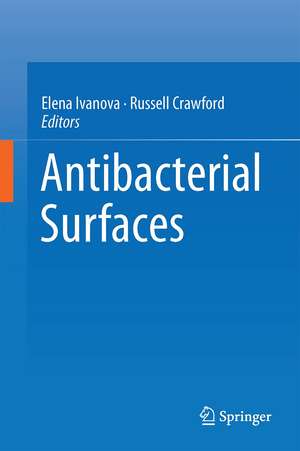Antibacterial Surfaces
Editat de Elena Ivanova, Russell Crawforden Limba Engleză Hardback – 17 noi 2015
This book discusses the mechanisms associated with the attachment of bacteria to surfaces and the main strategies currently being employed to control the initial attachment processes. These strategies are expanded upon in the subsequent chapters, where the definition and description of antibacterial surfaces are clarified, as are the mechanisms that come into play when determining the effectiveness of an antibacterial surface.
Subsequent chapters discuss a number of naturally occurring antibacterial surfaces, the methods currently being used for producing synthetic antibacterial surfaces, and the current and potential applications of such materials.
This book will be of great interest to people who work with materials that need to remain free of bacterial films, from designing safer biomedical implants to the production of self-cleaning materials where the prevention of biofilm formation has significant economic advantages.
| Toate formatele și edițiile | Preț | Express |
|---|---|---|
| Paperback (1) | 709.35 lei 6-8 săpt. | |
| Springer International Publishing – 23 aug 2016 | 709.35 lei 6-8 săpt. | |
| Hardback (1) | 719.02 lei 3-5 săpt. | |
| Springer International Publishing – 17 noi 2015 | 719.02 lei 3-5 săpt. |
Preț: 719.02 lei
Preț vechi: 756.86 lei
-5% Nou
Puncte Express: 1079
Preț estimativ în valută:
137.60€ • 142.78$ • 115.01£
137.60€ • 142.78$ • 115.01£
Carte disponibilă
Livrare economică 22 februarie-08 martie
Preluare comenzi: 021 569.72.76
Specificații
ISBN-13: 9783319185934
ISBN-10: 3319185934
Pagini: 220
Ilustrații: V, 172 p.
Dimensiuni: 155 x 235 x 15 mm
Greutate: 0.5 kg
Ediția:1st ed. 2015
Editura: Springer International Publishing
Colecția Springer
Locul publicării:Cham, Switzerland
ISBN-10: 3319185934
Pagini: 220
Ilustrații: V, 172 p.
Dimensiuni: 155 x 235 x 15 mm
Greutate: 0.5 kg
Ediția:1st ed. 2015
Editura: Springer International Publishing
Colecția Springer
Locul publicării:Cham, Switzerland
Public țintă
ResearchCuprins
1 Introduction to antibacterial surfaces, Hayden K. Webb, Russell J. Crawford and Elena P. Ivanova.- 2 Natural antibacterial surfaces, Song Ha Nguyen, Hayden K. Webb, Russell J. Crawford and Elena P. Ivanova.- 3 Simple to fabricate artificial antibacterial surfaces, A. Balcytis, Gediminas Seniutinas, F. Lapierre, Saulius Juodkazis.- 4 Electroactive antimicrobial surfaces, Paul J. Molino, B. Zhang, Michael J. Higgins.- 5 Manufacture of chemically modified antibacterial surfaces, Hitesh Pingle, Peng-Yuan Wang, Peter Kingshott.- 6 Design and fabrication of antibacterial metallic implant surfaces, Vy T. H. Pham, Chris M. Bhadra, Vi Khanh Truong, Russell J. Crawford, Elena P. Ivanova.- 7 Cytotoxic effects and biocompatibility of antimicrobial materials, Olha Bazaka and Kateryna Bazaka.- 8 Development of Fimbrolides and Halogenated Furanones as Antimicrobial Agents, Kitty K. K. Ho, Samuel K. Kutty, Daniel Chan, Renxun Chen, Mark D. P. Willcox, Naresh Kumara.- Index
Textul de pe ultima copertă
‘Antibacterial Surfaces’ covers the advances being made in the design of antibacterial surfaces, which have the ability to either prevent the initial attachment of bacterial cells, or kill any cells that come into contact with these surfaces.
This book discusses the mechanisms associated with the attachment of bacteria to surfaces and the main strategies currently being employed to control the initial attachment processes. These strategies are expanded upon in the subsequent chapters, where the definition and description of antibacterial surfaces are clarified, as are the mechanisms that come into play when determining the effectiveness of an antibacterial surface.
Subsequent chapters discuss a number of naturally occurring antibacterial surfaces, the methods currently being used for producing synthetic antibacterial surfaces, and the current and potential applications of such materials.
This book will be of great interest to people who work with materials that need to remain free of bacterial films, from designing safer biomedical implants to the production of self-cleaning materials where the prevention of biofilm formation has significant economic advantages.
This book discusses the mechanisms associated with the attachment of bacteria to surfaces and the main strategies currently being employed to control the initial attachment processes. These strategies are expanded upon in the subsequent chapters, where the definition and description of antibacterial surfaces are clarified, as are the mechanisms that come into play when determining the effectiveness of an antibacterial surface.
Subsequent chapters discuss a number of naturally occurring antibacterial surfaces, the methods currently being used for producing synthetic antibacterial surfaces, and the current and potential applications of such materials.
This book will be of great interest to people who work with materials that need to remain free of bacterial films, from designing safer biomedical implants to the production of self-cleaning materials where the prevention of biofilm formation has significant economic advantages.
Caracteristici
Covers the most recent advances in the field of antibacterial surface design Written by some of the world’s leading researchers in this field State-of-the-art information on the latest biomedical antibacterial technology











